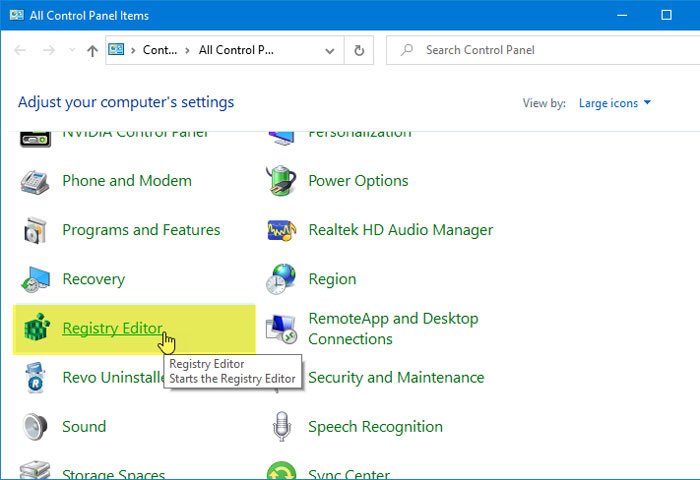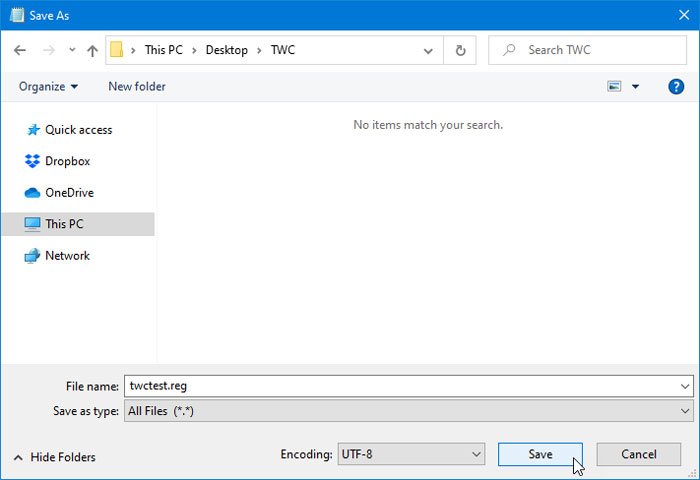In this post, we will show you how to add Registry Editor to Control Panel on a Windows 11/10 PC. Although Microsoft moved several options from the Control Panel to the Windows Settings in Windows 11/10, the former still has a lot of settings that are not available in the latter. If you tend to use the Control Panel a lot and also access Windows Registry from time to time, then you can add the Registry Editor to it so that you can use it without the Run prompt or the Windows Search box. It is useful when you need to run the Registry Editor frequently.

Registry Editor is a very handy tool, which comes with the system itself. You can open Registry Editor and make different changes as per your requirements. From changing the default image editor to enabling the Dark Mode, you can do every type of customization using Registry Editor.
We will help you to add the Registry Editor option to the Control Panel by creating a .reg file with Notepad or any other text editor.
How to add Registry Editor to Control Panel
To add Registry Editor to the Control Panel on a Windows 11/10 computer, follow these steps-
- Search for Notepad in the taskbar Search box.
- Click on the corresponding result to open Notepad.
- Paste the Registry values.
- Go to the File menu.
- Select Save As from the list.
- Select a location where you want to save the file.
- Type a name according to your desire.
- Enter .reg at the end of the name.
- Select All Files from the Save as option.
- Click the Save button.
- Double-click on the saved file to run it.
- Select the Yes button in the UAC prompt.
- Click the Yes button to confirm the addition.
Let’s delve into the steps in detail.
First, open the Notepad on your computer. For that, search for “notepad” in the Search box and open the corresponding result. After that, paste the following text in the Notepad window-
Windows Registry Editor Version 5.00
[HKEY_CLASSES_ROOT\CLSID\{2AF5D196-7BE1-42EE-8F48-F826F2690A27}]
@="Registry Editor"
"InfoTip"="Starts the Registry Editor"
"System.ControlPanel.Category"="5"
[HKEY_CLASSES_ROOT\CLSID\{2AF5D196-7BE1-42EE-8F48-F826F2690A27}\DefaultIcon]
@="%SYSTEMROOT%\\regedit.exe"
[HKEY_CLASSES_ROOT\CLSID\{2AF5D196-7BE1-42EE-8F48-F826F2690A27}\Shell\Open\Command]
@=hex(2):25,00,53,00,79,00,73,00,74,00,65,00,6d,00,52,00,6f,00,6f,00,74,00,25,\
00,5c,00,72,00,65,00,67,00,65,00,64,00,69,00,74,00,2e,00,65,00,78,00,65,00,\
00,00
[HKEY_LOCAL_MACHINE\SOFTWARE\Microsoft\Windows\CurrentVersion\Explorer\ControlPanel\NameSpace\{2AF5D196-7BE1-42EE-8F48-F826F2690A27}]
@="Registry Editor"
After that, click the File menu and select the Save as option. Alternatively, you can use the Ctrl+Shift+S hotkey to open the Save as box. Now, you need to choose a location (Desktop or anything else) where you want to save the file, enter a name with .reg extension (say TheWindowsClub.reg) and choose the All Files option from the Save as type drop-down list.

After that, click the Save button. Now, you need to open the saved file to add Registry values to the Registry Editor.
For that, double-click on the newly created .reg file, click the Yes button in the UAC prompt, and the same button in the next window to confirm the action.
Now, open the Control Panel to check if the Registry Editor option is added or not. If everything goes correctly, you can see the Registry Editor option in the Control Panel. You need to set the View by as Large icons or Small icons to get the option in your Control Panel.
That’s all!
Related: How to add Local Group Policy Editor to Control Panel
How do I enable Registry Editor in Command Prompt?
If you want to open the Registry Editor window using CMD in Windows 11/10, then open the Command Prompt window, type regedit, and hit the Enter button. When the UAC prompt appears, press the Yes button, and the Regedit window will open. On the other hand, if you want to restore Registry using Command Prompt, then restart your PC in Advanced Startup Options screen > Troubleshoot > Advanced Options > Command Prompt. Now change the directory to System32, copy Registry files from the RegBack folder, and paste them into the config folder (under System32). Restart your PC.
What is the shortcut to Registry Editor?
If you want to create a desktop shortcut to Registry Editor, then first open the Shortcut wizard. In the next step, add regedit in the text field, and press the Next button. Now give a name to the shortcut and press the Finish button. A Regedit desktop shortcut will be created. Double-click on that shortcut whenever you want to open the Registry Editor window.
Read next: How to hide Programs from the Control Panel in Windows PC.
Leave a Reply